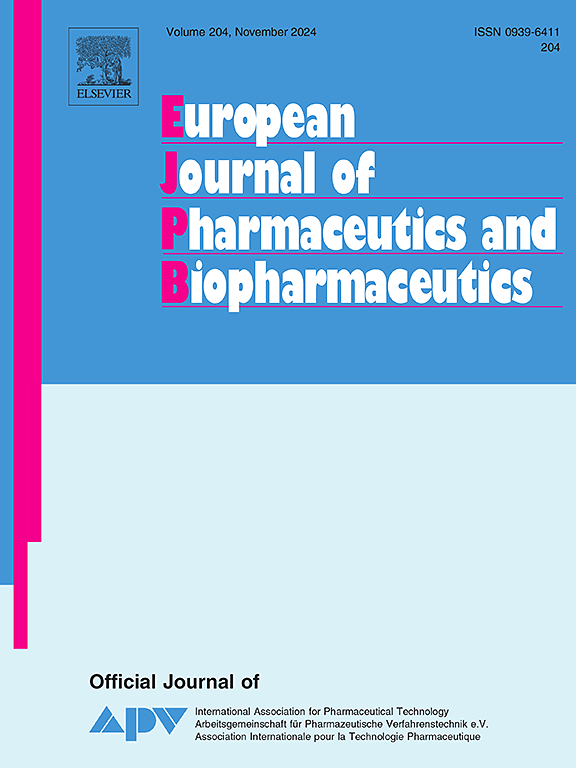Patches containing quercetin microcapsules to ameliorate dermal herpes simplex virus injuries in mice
IF 4.4
2区 医学
Q1 PHARMACOLOGY & PHARMACY
European Journal of Pharmaceutics and Biopharmaceutics
Pub Date : 2025-02-01
DOI:10.1016/j.ejpb.2025.114631
引用次数: 0
Abstract
This study aimed to develop patches containing quercetin-loaded microcapsules and to evaluate their in vitro and in vivo safety and efficacy in preclinical surveys. A set of in vitro experiments evidenced the virucidal activity of quercetin against the HSV-1-KOS (sensitive to acyclovir) and HSV-1-AR (resistant to acyclovir) strains, with improved outcomes upon the first. The patches presented a homogeneous aspect, were easily handled, had a suitable bioadhesion, and possessed mechanical properties of soft and weak material, besides a pH compatible with human skin. The in vitro release profile of quercetin showed an initial burst release, followed by a controlled release rate, which was best described by Gompertz kinetics (R2 of 0.93). Using quercetin-loaded patches for treating HSV-1-KOS-induced injuries was feasible since they were well tolerated in the in vivo skin irritation test and significantly decreased the injury scores until the fourth out of eight days of treatment in mice compared to acyclovir cream (50 mg/g). Altogether, the in vitro and in vivo antiviral assays indicate that this flavonol acts in the earlier stage of the infection, likely impairing the HSV-1 adsorption to the cell. The anti-inflammatory capacity of the quercetin-loaded patches was noteworthy as evidenced by histological analysis. These findings bring prospects for safer and more effective management of mucocutaneous HSV-1 injuries.

槲皮素微胶囊贴片改善小鼠皮肤单纯疱疹病毒损伤。
本研究旨在开发含有槲皮素微胶囊的贴剂,并通过临床前研究评估其体外和体内安全性和有效性。一系列体外实验证明槲皮素对HSV-1-KOS(对阿昔洛韦敏感)和HSV-1-AR(对阿昔洛韦耐药)具有抗病毒活性,前者效果更好。该贴片具有均匀性,易于处理,具有合适的生物粘附性,具有柔软和弱材料的机械性能,pH值与人体皮肤相容。槲皮素的体外释放曲线表现为最初的爆发期释放,随后是一个可控的释放速率,用Gompertz动力学(R2 = 0.93)最能描述该释放速率。与阿昔洛韦乳膏(50 mg/g)相比,槲皮素贴片在体内皮肤刺激试验中耐受性良好,并且在8天治疗的第4天显著降低了小鼠的损伤评分,因此使用槲皮素贴片治疗hsv -1- cos诱导的损伤是可行的。总之,体外和体内抗病毒实验表明,这种黄酮醇在感染的早期阶段起作用,可能会损害HSV-1对细胞的吸附。组织学分析表明,槲皮素负载贴片具有显著的抗炎能力。这些发现为更安全、更有效地处理皮肤粘膜1型单纯疱疹病毒损伤带来了前景。
本文章由计算机程序翻译,如有差异,请以英文原文为准。
求助全文
约1分钟内获得全文
求助全文
来源期刊
CiteScore
8.80
自引率
4.10%
发文量
211
审稿时长
36 days
期刊介绍:
The European Journal of Pharmaceutics and Biopharmaceutics provides a medium for the publication of novel, innovative and hypothesis-driven research from the areas of Pharmaceutics and Biopharmaceutics.
Topics covered include for example:
Design and development of drug delivery systems for pharmaceuticals and biopharmaceuticals (small molecules, proteins, nucleic acids)
Aspects of manufacturing process design
Biomedical aspects of drug product design
Strategies and formulations for controlled drug transport across biological barriers
Physicochemical aspects of drug product development
Novel excipients for drug product design
Drug delivery and controlled release systems for systemic and local applications
Nanomaterials for therapeutic and diagnostic purposes
Advanced therapy medicinal products
Medical devices supporting a distinct pharmacological effect.

 求助内容:
求助内容: 应助结果提醒方式:
应助结果提醒方式:


